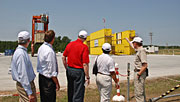- Number 342 |
- July 25, 2011
New approaches to scanning cargo containers

Visitors at On-Dock Rail VIP Day
at SRNL watch a demonstration
of how large cargo containers
could be scanned for radioactive
material using the Straddle
Portal Prototype.
DOE’s Savannah River National Laboratory is winding down the initial phases of testing of prototype systems for detecting radioactive material in cargo containers unloaded from ships. Next, the systems head for the Port of Virginia in Norfolk for testing in a real-world setting. This testing is being conducted by the Department of Homeland Security (DHS) Domestic Nuclear Detection Office (DNDO) as part of the On-Dock Rail (ODR) program.
A group of VIPs, including congressional staffers and representatives of two DHS agencies, recently visited SRNL to see a demonstration of the system and its testing procedures first-hand.
“The visit was held primarily to demonstrate testing activities associated with this new radiation detection capability but it also gave us a chance to show off the great team we have hard at work on this important effort,” said Al Goodwyn, SRNL’s Director of Homeland Security Programs.
SRNL is being funded by the DNDO to develop and test the ODR system as a potential alternative for enhancing the capability for scanning intermodal cargo containers that are moved directly from ship to rail at seaports, to prevent the entry of illicit radiological and nuclear materials. DNDO is conducting an analysis of alternatives to determine whether a technology or suite of technologies advances radiological and nuclear scanning capabilities, reduces the time that containers are sequestered for scanning, and/or reduces the number of container movements required to permit scanning.
This project is one in a number of campaigns that SRNL has conducted for DNDO in recent years, testing numerous different kinds of radiation detectors for DNDO in different traffic environments, whether on land or water.
One component of the ODR is the Straddle Portal Prototype (SPP). SRNL is responsible for the design, fabrication, integration, and testing of this system, which uses stacks of empty cargo containers to form a portal. The large (40 feet high) straddle carriers that are used to move cargo containers from the ships to the rail would drive through this portal, where they would be scanned by one of two types of detectors. Depending on which type was used, the detector would either alarm at any radiation above background, or alarm and identify the isotopes. Because the portal is assembled from empty cargo containers – which are inexpensive and readily available at seaports - this design is a less expensive mounting platform than designing, building and anchoring a structural frame.
Submitted by DOE's Savannah River National Laboratory
